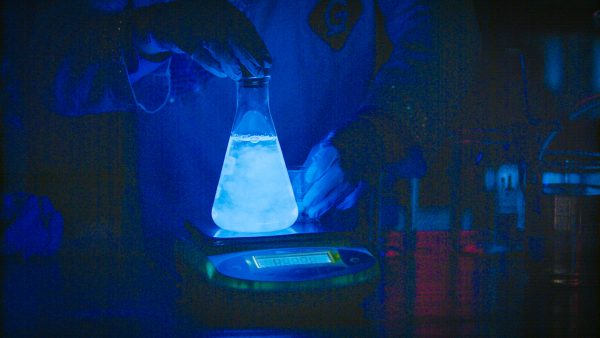Compound Definition
A compound forms when atoms from different elements combine, creating a substance with new properties. For example, combining hydrogen and oxygen forms water, a compound with unique characteristics.
View Lesson on Chemical Reactions
Become a member to get full access to our entire library of learning videos, reading material, quiz games, simple DIY activities & more.
Become a member to get full access to our entire library of learning videos, quiz games, & more.
Plans & Pricingto watch this full video.

Access All Videos
and Lessons, No Limits.
Access All Videos

No credit card required,
takes 7 sec to signup.
No card required

Ready-to-go lessons
that save you time.
Ready-to-go lessons
If you are on a school computer or network, ask your tech person to whitelist these URLs:
*.wistia.com, fast.wistia.com, fast.wistia.net, embedwistia-a.akamaihd.net
Sometimes a simple refresh solves this issue. If you need further help, contact us.
Chemical Reactions
Fun Facts
- Burning steel wool forms the compound iron oxide from iron and oxygen.
- The compound hydrogen peroxide breaks down into water and oxygen gas with a catalyst.
- Luminol reacting with the compound hydrogen peroxide produces light and nitrogen gas.
Why Do We Need To Know About Compound
Learning about compounds helps us know how chemical reactions work. This is important for making new medicines and advanced materials. Scientists use these reactions to make new drugs that can save lives and to create new kinds of materials.
This knowledge helps in making better rocket fuels for space travel and in making new types of solar cells for cleaner energy. Understanding compounds and how they react with each other is key in many fields. Chemistry is essential in solving different problems and helping technology move forward.
Frequently Asked Questions
Check out the Full Lesson on Chemical Reactions
In this lesson, we learn that:
- When substances undergo chemical reactions their properties change.
- The total number of atoms does not change throughout a chemical reaction.
- Scientists use chemical reactions to create new materials and medicines.
Related Topics
- Air Mass Definition
- Analog Signal Definition
- Astronomy Definition
- Cellular Respiration Definition
- Chemical Reaction Definition
- Chemistry Definition
- Circuit Definition
- Comparative Anatomy Definition
- Compound Definition
- Conservation Definition
- Continental Drift Definition
- Definition Of Engineering
- Definition Of Human Body Systems
- Definition Of Living Things
- Definition Of Science
- Earth’s Axis Definition
- Ecosystem Definition
- Electromagnet Definition
- Engineering Definition
- Erosion Definition
- Food Web Definition
- Generator Definition
- Germination Definition
- Group Behavior Definition
- Humidity Definition
- Igneous Rock Definition
- Information Transfer Definition
- Internal Structures Definition
- Kinetic Energy Definition
- Latitude Definition
- Marsupial Definition
- Mass Definition
- Multicellular Definition
- Particle Model Of Matter Definition
- Photosynthesis Definition
- Physical Map Definition
- Pull Definition
- Reactants Definition
- Sedimentary Rock Definition
- Seismologist Definition
- Snow Definition
- Sound Definition
- Symbiosis Definition
- Synthetic Materials Definition
- Taxonomy Definition
- Total Eclipse Definition
- Tsunami Definition
- Water Erosion Definition
Start a Free Trial Today. Get a $5 Amazon Gift Card!
Teachers! Start a free trial & we'll send your gift card within 1 day. Only cards left. Try it now.
Select Grade
Select Subject
This email is associated with a Science Kit subscription. Kit subscriptions are managed on this separate page: Manage Subscription

-
Download InvoiceScience & Math$/yr
-
Download InvoiceScience Only$/yr

access all lessons
• No credit card required •
"My students loved the videos. I started the video subscription in May and used them as a review before the state test, which I know contributed to 100% of my class passing the state test."
Rhonda Fox 4th Grade Teacher, Ocala, Florida
Use Generation Genius in Your School
Access all lessons free for 30 days.
"My students loved the videos. I started the video subscription in May and used them as a review before the state test, which I know contributed to 100% of my class passing the state test."
Rhonda Fox 4th Grade Teacher, Ocala, Florida
• No credit card required •
Already a member? Sign In
* no credit card required *

* no credit card required *
* no credit card required *


to Discover the Benefits of Generation Genius
Learn How to Save for Your School & District!

no credit card required
Skip, I will use a 3 day free trial
Enjoy your free 30 days trial
-
Unlimited access to our full library
of videos & lessons for grades K-5. -
You won’t be billed unless you keep your
account open past your 14-day free trial. -
You can cancel anytime in 1 click on the
manage account page or by emailing us.
-
Unlimited access to our full library of videos & lessons for grades K-5.
-
You won't be billed unless you keep your account open past 14 days.
-
You can cancel anytime in 1-click on the manage account page.
Cancel anytime in 1-click on the manage account page before the trial ends and you won't be charged.
Otherwise you will pay just $10 CAD/month for the service as long as your account is open.
Cancel anytime on the manage account page in 1-click and you won't be charged.
Otherwise you will pay $10 CAD/month for the service as long as your account is open.
We just sent you a confirmation email. Enjoy!
DoneWe use cookies to make your experience with this site better. By using this site you agree to our use of cookies. Click "Decline" to delete and block any non-essential cookies for this site on this specific property, device, and browser. Please read our privacy policy for more information on the cookies we use.Learn More
We use cookies to improve your experience. By using this site, you agree to our use of cookies. Click "Decline" to block non-essential cookies. See our privacy policy for details.Learn More




























































































































